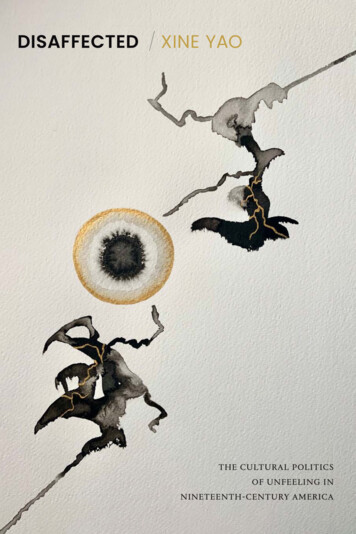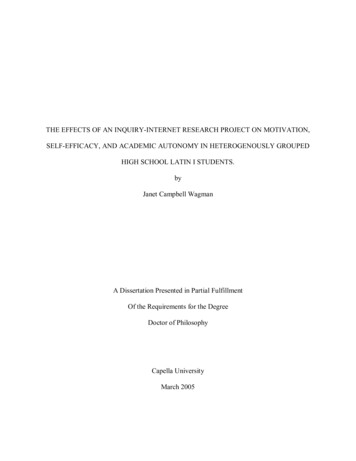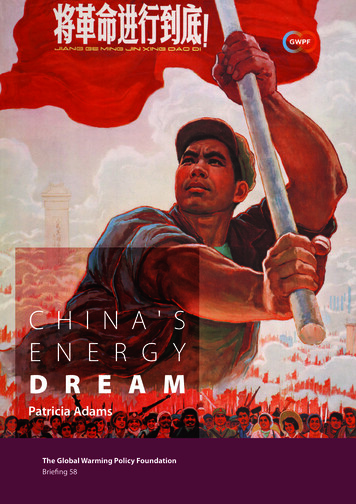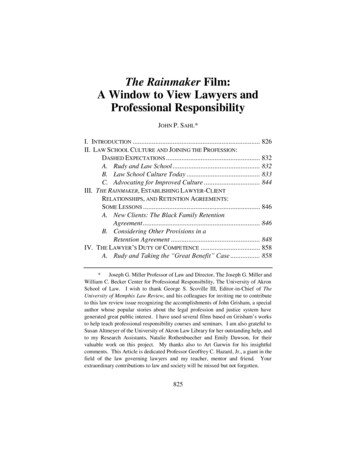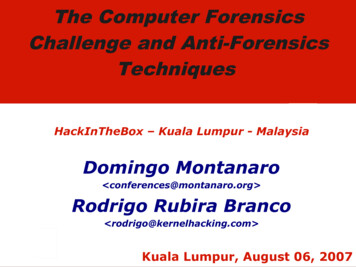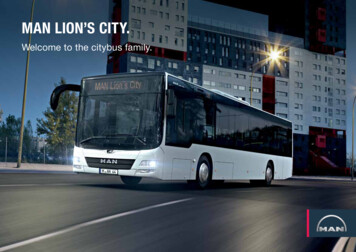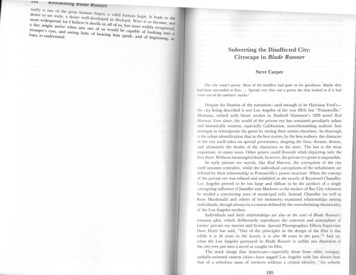
Transcription
,-.,r(Jr/,ily isnmnw IIlmlr' /(u"",.OIlCoflilt'1S"t'HIhUIMll1"oP(', , 11VllililIlllIlI.11i/rIlP("Itleads10 IllI'desire to see truly, a desire well-developed ill Deckard, W("/'c it to becomc, 1101more widespread, for I believe it dwells in all of us, but more widely recognizf'lI,a day might arrive when anyoneof us would be capable of looking intstranger's eyes, and seeing him; of hearing him speak, and of beginning, IIIleast, to understand.Subverting the Disaffected City:Cityscape in Blade RunnerSteve CarperThe city wasn't111111been successfulIIIIIICpretty.Most of the buildersat first. . Spreadout of the smelters'had gone in for gaudiness.over this was a grimysky that lookedMaybe theyas if it hadstacks1Despite the flatness of the narration-aridenough to be Harrison Ford'sis not Los Angeles of the year 2019, but "Poisonville,"Montana, etched with blunt strokes in Dashiell Hammett's1929 novel RedIlarvest. Ever since, the world of the private eye has remained peculiarly urban,lI1d historically western, especially Californian, notwithstandingauthors' best,Iflempts to reinvigorate the genre by setting their stories elsewhere. So thoroughis the urban identification that in the best stories, by the best authors, the characterof the city itself takes on special provenance, shaping the lives, dreams, desires,and ultimately the deaths of the characters in the story. The last is the mostimportant, in many ways. Other genres could flourish while depicting only thefirst three. Without meaningful death, however, the private e;'e genre is impossible.In early private eye novels, like Red Harvest, the corruption of the cityitself assumes centrality, while the individual corruptions of the inhabitants aredefined by their relationship to Poisonville's power structure. When the conceptof the private eye was refined and solidified in the novels of Raymond Chandler,Los Angeles proved to be too large and diffuse to be the product of a singlecorrupting influence (Chandler sent Marlowe to the enclave of Bay City wheneverhe needed a convincing aura of municipal evil). Instead, Chandler (as well asRoss Macdonald and others of his imitators) examined relationshipsamongindividuals, though always in a context defined by the overwhelming theatricalityof the Los Angeles mythos.Individuals and their relationshipsare also at the core of Blade Runner'stenuous plot, which deliberately reproduces the concerns and atmosphere offorties' private eye movies and fiction. Special Photographics Effects SupervisorDave Dryer has said, "One of the principles in the design of the film is thatwhile it is 40 years in the future, it is also 40 years in the past."2 And yet,what the Los Angeles portrayed in Blade Runner is unlike any depiction ofthe city ever put into a novel or caught on film.The stock image that Americans-especiallythose from older, compact,radially-orientedeastern cities-havetagged Los Angeles with has always beenthat of a nebulous mass of enclaves without a central identity, "six suburbsI II(' city being described185
·"-11 H. lIuar IT,nur IflIDUfill search of a city." ConlJecting the city's 1I11111('I()I( N(rllllI'lJS :01'(' Ilrl' /""ill"freeways, so crucial to Los Angeles' identity that RCYllcl' Ihr)harn, an a.rchiil"l 111111critic who applauds some of the oddities in Los Angeles architecture willi Iiother critics deplore, has elevated them to the status of an "ecology," 101, Ill/with Los Angeles' three most characteristic geographic features: the bradl!the foothills, and the central valley. These four ecologies form the detennillllllfactors for L.A. 's distinctive architecture,as well as for the city's distinl'lIl'latmosphere in its private eye novels. No case of Marlowe's fails to incJud(' l(passage in which he enters a seedy valley office building in search of informatiollfrom its eccentric occupants or travels the winding streets of the cloistered hilIsid,.to interview a wealthy client. Though Marlowe once invades a gambling shl"safely ensconced beyond the three-mile limit, it is Lew Archer who is mOIlidentified with the beaches, and the ecological devastation which they SUCCI'IInteresting echoes of these scenes occur in Blade Runner, but all are twisledto fit the transformed city of the future,ecologies are unaccountably missing.a city in whichall four distinctivl'Critics, even those who otherwise despised the picture, gave almost universalacclaim to the stunning visual creation of the future city in Blade Runner, aseemingly densely real creation which grafted futuristic imagery over the basI'of grittily textured leftovers from today's L.A. Most responsible for the lookof Blade Runner's L.A. 2019 is Syd Mead, given the screen credit of "VisualFuturist," though he prefers the term "conceptualist. someone who thinks uphow things might look [in] a specific setting and time frame."4Mead's Los Angeles is a towering, restricted city, belying the vast expanseintimated in the film's opening shot. Much truer to the future city's image isthe scene in which Deckard is introduced aglittering neon world of advertisingand enticing images perched high on skyscrapers hunched over the tackily ethnicrowds bustling past street-level shops, stores, and vendors. Taken on a tripof .3000 miles no less than 40 years, the viewer has been plunged into TimesSquare 2019. Tellingly, the street scenes were created on the New York Streetset at The Burbank Studios.5Mead has accomplished in Blade Runner what generations of city plannershave failed to do in reality: he has given Los Angeles a downtown. HorizontalL.A. has vanished into vertical New York. The foothill ecology in which heightabove the sprawling valley confers status is replaced by a Manhattanite rankingof the number of stories one is above the ground. The dominating700-story6headquarters of the Tyrell Corporation proclaims its wealth and status in thisnew inverted world by the sheer fact of its bulk, rather than by the picturesquenessof its site as is more usual in the laid-back Californian high-tech current cliche.Conspicuously,Deckard lives on the 97th floor of his apartment house.Although his piano provides the same cultural connotations as Marlowe's chessset, Marlowe's seedy apartment can hardly compare with Deckard's 2lst centurysplendor. The Mayan motif of Deckard's apartment is ironically liberated froma Frank Lloyd Wright house easily as monumentalas the far vaster bulk ofTyrell's Mayan pyramid. Whatever the homage, Deckard's apartment ties himfirmly to the era of L.A. 's golden age, for which Marlowe often nostalgicallyyearns, and provides a stage for the personalizingclutter which would beinconceivable in Tyrell's spacious and sterile environment. t.VI', /l1Ip.011(' nfr4ltrr.,(jc'clell y1Ii?'I'I\(' Oi viollHly '1IIIiIIv, d ",1(11 isti!' splelldor of Tyrell'shottle alldIWIlt/quarlers compal'('/! pow Iy WII h i he use of current L.A. landmarks to demarkilil' horne territory of Iht, other Angelenos in Blade Runner,7 because the cartoonyI'YI('/' never achieves the texture that their integration into a believably complex, liyNcape offers. It is impossible to picture Tyrell outside the walls of-his fortress,while all the unnamed street people and vendors who supply backdrops forIII(' stars appear to have been caught in mid-stride by a camera setup, and even11,(, feplicants manage to blend themselves invisibly into city life.In contrast to Tyrell, J.F. Sebastian's ineffectualness and pathos are welldiNplayed by placing him not in upwardly mobile surroundings(he is, afterd I, a genetic engineer who presumably earns far more money than a lowly bladeIlInner like Deckard) but in the decaying Queen Anne splendor of the BradburyJHlilding. Though the building is more convincingly seedy than Deckard's, some"vidence of Sebastian's status is hinted at by the vastness and isolation of his.(partment, physically and emotionally removed from the teeming crowds of streetpeople below.Works of science fiction have never handled well the depiction of lower,Iniddle, and upper class society simultaneously, even though detectives in privateeye novels manage to move from one environmentto another as a matter ofcourse. Chandler'sbooks dependheavily uponthe split, socially andgeographically,between the lower classes and the upper classes, his Midwesternmiddle-class innocents tending to gravitate toward one end or the other soonafter their arrival. Blade Runner's use of the private eye allows it more freedomto roam through these various worlds than in many science fiction films. Deckard'sjourney to the heights of Tyrell's office is meant to correspond to Marlowe'strips into the hills to visit his wealthy clients, just as his visit to Leon's hotelroom has its parallels in many of Chandler's novels. The difference is thatChandler makes Marlowe's movements to and fro across the vast Los Angelesmetropolis concretely meaningful,street directions charting his course acrossthe emotional and sociological topology of the city. Sebastian's lonely existencein ferociously overcrowded L.A. 2019 may be meaningful, but we cannot knowbecause no sense of place ever develops in Blade Runner. While one of thehallmarks of the L.A. private eye novel is its incessant movement, travel withoutdestination,Blade Runner gives us destination without travel. Flying policespinners disdain the world-famousboulevards, and ignore the ecology of thefreeways.Tyrell's headquartersalso seems to disdain the textured reality of streetlevel Los Angeles. Except for the lack of bridges and skyways connecting itto other impossibly huge structures, the building is merely the latest updatingof the megastructurefound in every stock shot of the future since the heydayof Amazing Stories magazine:The city of tomorrow, engineers say, will tend first to vastness-gigantic buildings connectedby wide suspended roadways on which traffic will speed at unheard of rates. Helicopterplanes, capable of maneuvering about between buildings and roof-top airports, will takethe place of the ground taxi. Each building will be virtually a city in itself, completelyself-sustaining . .s
nmHI.The height alld mass, thc oUlsidc ekvlIlol', IIt(, /-III/willI{ ' I':II(,/illHIII, Ihllanding strip for flying vehicles, all combine to symbolil.c "futurc;" in f hI' ( III hi tIterms of wealth, progress, and the triumph of technology.How odd, then, to find the building squatting in Blade Runner'S LOR AIIHI'II'Althoughtotally unexplainedin the movie, scattered futuristic elemclllN. 1111calls to emigrate to the outer colonies, the rarity and expense of real anillHtImust be assumed to be allusionsto Philip K. Dick's novel. A know/culIl' IIIthe novel fills in the missing subtext-thatthe off world colonies have aUnl1the best and brightest of Earth's population,leaving behind a shattered eCOIl()IIIVthe useless dregs of humanity,and those who either cannot leave their hOlilior who profit from the removal of competition.Individual pockets of innov 1I jll"remain, to be sure. Genetic engineeringhas advanced beyond our comprehensil 1/1and Deckard's computer is surely the envy of every hacker. Even so, Los Ange'llhas obviously been shattered by some mysterious calamity, to the point wIll'''it bears similarity to post- World War IILondon. Both cities maintain the gianlisltlof a fabled past, but are technologicallyand socially suspect because the Vilillmajority of their resources have been siphoned off to younger and more vigoI'olicultures.,,01In this atmosphere,Tyrell's headquartersis as much outside reality as alloptical illusion in an Escher print. Architectureis a cooperative art, dependclIlupon thousandsof concomitantadvances in structuralengineering,materialdesign, spatial analysis, communicationstheory, and the sociology of largl'groups. Solving the practical problems of constructingso monstrous a building,not to mention making provisions for all the workers necessary to staff it, wouldcreate as much of a social revolution as did the creation of the first true skyscraperin the first decades of this century. Certainly, little evidence of this revolutiollcan be found elsewhere in Blade RunnerThe social structures such buildingsimply are also nowhere to be foundin the movie. Where in a dying world would Tyrell have found the financialresources to build his monument?What does Tyrell do in his headquartersthairequires such unimaginablequantitiesof space (not even leaving room for th('manufacturingfacilities of his eyeball designers)? Where in a world of streelpeople, misfits, and municipalguardians does Tyrell find the tens or hundredof thousands of people needed to staff a blocks-long,700-story high complex?While the success of the city in Blade Runner lies in the cohesivenessof itsocial structure,the feeling that characters continueto exist as they pass offscreen, Tyrell headquartersfails to convince-andvanishes as soon as we leaveit behind.Does the corporationeven exist? Only three Tyrell employees are ever shownin Blade Runner-Tyrellhimself, Sebastian, and the eyeball designer, Chewand by the end of the movie all must be presumed dead. All that is left of theTyrell Corporationon Earth is a lone replicantwhose immediatemove is toleave the corporation'smonolithicsymbol behind. With everyone gone, onewonders whether the Tyrell Corporationitself will not pop out of existencelike a god whose followers have all died.While Tyrell lives, however, his existence fuels the plot, for without hispresence in Los Angeles, the replicantswould have no need to make theirhazardous way from the outer colonies to Earth.9 Immigrationis the great themeII 111(' hhHOI'Y of I.ON !\nl-\('/('M, IIIII h'dOVCI' illto its privateeye fictiou by writer'S :1I:lIlcllcr and Macdollald,Arr1c;ricans raised outside the country. Their1111It 1'1 liS were social ones, ratherthan political,"exile, cultural duality anddIHIIH":rtion, class distinctions,wealth, success, and social responsibility."loMostIII I Ite charactersin L.A. private eye fiction have come to Californiafrom 1I11I\:whcre else, often from sleepily innocent Midwesterntowns, searching forrill' Ilew Eden which Los Angeles advertised itself as being. California allowedI It(· immigrantsto cast aside their perceived failures and dare to hope for a newIII'/olinning, "the myth of a future."1lentral to Chandler and Macdonald'sworks is that neither the past norI hI' future Eden can ever be gained. The old ways, the old battles,the oldI OI'l"uptions have been brought to California by the supposed innocents, taintingi hI' futurein a way that not even the knightlyskills of a Marlowe canIllunterbalance."The cities in these stories are dark broodingplaces of oldhili/dings and collapsingrelationships. Shadows darken even the most welllif.;"hted places and line the most innocent of faces."12 Golden Californiahaslong since ceased to exist. Blade Runner, for all the critical comment on itsdamaged ecology as evidenced by the perpetual rain and smoke, is only fractionallydarker and wetter than Howard Hawks' The Big Sleep.If the future is corrupted,then the future is also apt to be very short. Thosewho survive the longest are those who have learned to read the city and adaptI hemselvesto its rhythms.Marlowe is the best example of this. A Californianative, but not from Los Angeles, he has come to understand the city by inhabitingit as an anthropologistgoing native would, eating unprepossessingfood at its, qualid drugstore counters, endlessly driving its boulevards and freeways lateal night. Deckard, eating in the street-level diners of the "little people," knowingIheir lingo because "every good cop does," is a reflection of this mandate toknow and comprehendevery aspect of his city.The success of characters in private eye stories depends upon their ability10 thrive in their new environment,especially by cynically using others beforeIhey can be used by them. For example, in Chandler'sThe Little Sister, DoloresGonzalez has taken on the flamboyantpersona of a Mexican spitfire, walking:asily throughthe glamorousworlds of movie stars and gangsters. Her onelime husband,Dr. Vincent Lagardie, successfully practices as a neurologistinan office "not quite in the best residentialneighborhoodand not quite out ofil. "13 In sharp contrast, Lester Clausen and George Hicks live on the flophousefringesof respectableL.A. Theirclumsyattemptsat manipulationarecontemptuouslybrushed aside; they are the first characters in the novel to die.So too in Blade Runner. The replicants,new not only to Los Angeles butto the entire cultureof Earth, show an uncanny ability to learn quickly howto mask themselves in the city and manipulateothers to achieve their goals.After a single failure, a frontal assault on the Tyrell Corporationheadquarters,results in the death of one of the replicants, the others quickly adapt. Pris becomesa believable runaway waif, enticing Sebastian to take her into his home. Leonsoon gains employmentat the Tyrell Corporationitself, althoughhis lowintelligencelevel results in his quickly being discovered. Roy schemes as theking on the chessboard, using all others as pawns, just like the murderer revealedat the end of any of Chandler'sor Macdonald'snovels.Ilk"
I!JOBlade Runner being a "dusl(;I' of II I:II rI/toNIillll'l.((lslhilili('s,""Ilris 1111111111'1can be taken only so far. Zhora's role a a Nlrip))l'l' willi a snake :11'1, wldlt Iperfect example of the unbelievable ability of the )'epJicants to bklld illii' 1111alien culture, seems to have no connection with any of Roy's schemes. F,ld" IZhora is simply off by herself trying to survive (as, presumably, is Ih(' ,ojl 11ireplicant, whom the filmmakers have utterly forgotten about) or else Ir(' N('( VImerely as an homage to the Gonzalez role in Marlowe, the James Garner V('I' IIIIIof The Little Sister. As the same scene features Harrison Ford's homage to BOI\IHI'.bookstore scene in The Big Sleep, perhaps this subplot is merely an illu II'lIII""of Pauline Kael's remark that "Some of the scenes seem to have six subh' 1but no text, and no context, either."15Even the most successful of Chandler's assimilators tend to meet early d(,l(ill"and the success of the replicants in creating hope for themselves in the I .Aof possibility and future must be equally short-lived. Though the Los AnµI"1of 2019 seems on the surface to be an overcrowded jungle, worse even thall tillperceptions of the present-day New York which it apes, no casual violent'!' Ito be seen on its streets. All the deaths occur within the family of individlHIIwho are their brothers' makers as much as their keepers. Each death is meaningflllin the display of emotions it engenders, in the affirmation of life which is IIpurpose in the private eye genre. Pris' extraordinary life force exploding (1'0111her wounded body, Leon's death instigating fear and love in Rachael and Deckald,Roy's mystic heightened consciousness as his life force novas and fades are l('JIin the rehabilitation of Deckard's humanity. At the same time, each death dependfor its impact on one of the cultures in the city the movie explores: the futurisllioffice, the shabby room in a relic of the past, and the frenetic, neon-lit strccl,culminating in the life-giving death on the rooftops of this vertically transfornll'dfuture Los Angeles.Deckard's position at the beginning of the movie, trapped in a city alit!a role he cannot escape, is more typical of the private eye's dilemma at 1111'end of a novel. Though the murderer has been caught, or at least identifiedand neutralized, there is always less innocence than at the novel's beginnillf\.too many secrets have been loosed, too much corruption has been exposed. Til,'private eye must take this burden to the next case, where it can only grow heaviclNo wonder Marlowe became increasingly masochistic in his later books,Marlowe and those who came after him had no choice in continuing IIItake part in this loss of innocence. Once they had found the American Edellcorrupt where was there left for them to go? The dilemma of the private ey"is that of the closing of the frontier, the loss of the lure of a golden land evI'lbeckoning the unsatisfied loner. Some of the incessant travel in Los Angell'fiction undoubtedly betrays this yearning for a destination. Blade Runner suppl iCNnot just one destination but two, and in so doing ties itself firmly to a centuryold tradition in American literature, while breaking the constricting focus 01the private eye genre.The American spirit has often been defined in relation to its once seeminglyendless frontier. The individualism celebrated in those who broke the trail inlOthe wilderness, however, can also be read as a psychologicalmaladaption10the cities left behind. Such men were always useful: their painfully acquiredunderstandingof the land invaluable to later travelers, often well-meaningdl''''IIIII.II' I, hili Il:tiw c:IS(eI'l1CI'S,II II!I W:II'(;of Ih .:dangers ill lilt alien W(;Sl. MallYWIIII'INIllIV('noled Ihat the image of the loner using his special skills to protecttill' IIIIHII'('ot from evil is one which reoccurs often in American fiction, andIII(v,' IllIl'(,(/ its direct Lineage from the Old West gunfighter to the private eye.'I 'he American frontier started as a narrow strip along the Atlantic Ocean,hili was continuallypushed west in the search for an ever newer and even moreIlI'rI('('1goldell land (leaving New York City's streets, metaphorically paved withIII tid, for the very tangible gold around which western cities were built). EachIII I ('ssive frontier attracted with its promise (land, wealth, openness, freedom)Iliid discouraged with its reality (climate, hard work, violence). California was1hi' !:1st and the most perfect of American frontiers, and throughout this century11I('l'icans have been willing to close their eyes to its imperfections and makeillI'il' way there by the millions.Despite the vast open lands left in the American west, the urban developmentlit California in this century effectively ended the pursuit across the country.IIIIIC few maintainedtheir distance from all signs of civilization, but many1II0l'Cof the loners adapted themselves to the cities. Cities offered on a permanenthllsis the drink, sex, and gambling which were the inducements of the frontierIIIWII,and also proffered vast herds to prey upon. That they were people ratherIh:1I1 buffalo was a small matter. Between the hunters and their prey, neverIlI'longing to either for all his ties to both, walked the private eye, still ostensiblyIII,· protector of the innocent.By the time Philip Marlowe strapped on his gun, innocence was harderIII find in a corrupt city, whose corruptions extended into the lives of each ofIiis cI ients, The private eye story subverts the innocence of the classic western,howing that the young women, once the most in need of protection of all,wI'rr just as likely to prove to be murderers as were the thugs who were theirpil'iLUal opposites. Los Angeles had become "the end of the trail," the frontierIH(lIing up against the sea and spilling back upon itself. The corruption ofI,os Angeles is the result of this pressure without a release valve, the cleansingIlI'omised by the vast openness of the frontier no longer even an option. MarloweIlI'nds much of his twenty year career increasingly questioningthe rightnessIII his actions,nostalgically remembering a golden age before the millions whohilt! not yet gotten the message swarmed into a progressively more depraved1,os Angeles in pursuit of their own personal quests.Blade Runner depicts a radically different Los Angeles, one which Marlowewould have difficulty understanding.The frontier has receded once more, a newHolden land has opened in the outer colonies, The unsatisfied millions havedl'parted, leaving behind an unstable structure of a city which will soon crumbleInto a ghost town or be transformedinto the embodiment of a newer (seemingly(1I'iental) myth.Like their lives-bornas adults, searching for parents only as they diet he replicants'quest is retrograde, from the frontier to a metaphorically eastern(,lI1d Eastern) city. As befits its transformed state, elements of New York-thequintessentialeastern city-havedisplaced the distinctive atmosphere of LosAngeles-thequintessentialwestern city.16 The mighty metropolis itself drawslite disaffected from their small town worlds of dreams. Earlier in this centuryNcw York held the position which Los Angeles would later try to claim, the
W i{t'h'ul'iiiiIlKIJltulr'1 Ilml'UfJrbeginning and cnd, to which Ihc yOllng' !Iud bo))dlll 1'11111('ill NI'IIlI'1101 1111111and glory and from which Hawed the culture and stat IS whic'h ddllll'd 1\1111'1 j( (Today New York is more the representation of the urban nightmare, :1 ('111/11111111to be left behind,with the middle class rushing outward in every dll'l',1/1I11fleeing the central city and leaving it to the two groups best equipped III lul'lfull advantage of its polyglot possibilities: the fantastically wealthy and rill' NilII Ilevel poor.Blade Runner's identification of its cityscape with New York is now COIIIIIIII No longer is Los Angeles a symbol of a place which "held out the pl'O"d 1of personal success""the hope of avoided failure and of escaped tragedy,"11All the fugitive replicants die, violently, pace Roy Batty who dies in the 11I1t1 1of violence nonetheless. It is his quest which kills the others; he alone of 1111replicants cannot in any way comfortably co-exist with civilization. Their qll" 1is doomed from its inception in any case, their brief lives made even shol II Ibecause they were expending their final breaths straining to move in the WI'OIII'direction. It is a tenet in American genre fiction that escape can only be OUtWl1i dOutward can be defined in many ways. While the majority of peopk (IIIEarth seem to have fled to the golden land represented by the outer coloni,' ,hints are dropped that perhaps that future is as flawed as Los Angeles evemuallproved to be. As a self-contained individualist,Deckard is unlikely to respolldto heavy-handed government propagandaurging him to join the middle-elmmasses whose company he disdains. In addition, neither he-as a former bladlrunner-norRachael would be likely to be happy in a society obviously dependt'1I1upon replicants as virtual slave labor. (The virtues of the sex and companionshipoffered in the frontier town may live on in "pleasure model" Pris, but theN(are virtues only from an extremely narrow perspective,) Instead, when Decka!'dand Rachael flee they do so into a private world, seemingly created in frail Iof them as they fly, a world reminiscent of the descriptions of the bountifulAmerican west by the first pioneers, whose light and warmth and openness aI'('the antithesis of rain-shrouded L.A.It has been reported that Rachael and Deckard's flight was a last-minuli'patch on the movie ("pasted together out of what are said to be aerial outtak('from The Shining"IB). If so, it was a far more fortuitous addition than HarriSOnFord's narration, and one which truly weds the film's science fiction trappingsto the sturdy underpinningsof its detective heritage. Science fiction writers have'long known how powerful the imagery of the frontier is and its placement backinto the mythos of the private eye opens the possibilities of a revitalization ofthat genre in a future where innocence is still alive and values have meaningsonce again (along with the dramatic opportunitiesafforded in a society withfrontiers with widely varying moral structures). In fact, in the years since BladeRunner, a flood of sf private eye novels have appeared, both absorbing andextending the conventions of each genre.The enduring power and strength of genre fiction all too frequently comesfrom extra-literary elements. The themes of the loner and protector, of innocenceand corruption, of death and its piercing clarity buttress private eye fiction evenwhen the writing is trite and cliched or the characters shallow and predictable.The erasure of boundaries, the questioningof the familiar, the quest for themeaning of humanity carry much science fiction past similar failings. Theseh'Vc\.n'l ihc' I Jj/llllll'(,\('I',Illy'.,·pic'lIliflilill Illillill 1111/111111, 11Mweak c:l'ipt ; 11111.01 COllljl0HMUtC1'01'dil'eetion and woodclI ill liug.Even Syd Mead's brilliant future cityI"IiV('S to eontain contradictory clements and fares poorly upon close examination.Despite this, the strengths of the two juxtaposed genres here dynamically11,1 IIforce one another. The private eye's questioning of surface appearances mesheswl'lI with science fiction's probing of the truth of our most basic assumptions.The illuminating light that death in the detective novel throws upon the realitypI' human relationshipsis very near the distancing view science fiction uses toI('veal ourselves to ourselves. Science fiction, paradoxically obsessed with space,lIld openness as much as with boundaries and frontiers, offers an escape toIidllllt{Mill'('II. III 'plII I-(cnreincreasinglypreoccupiedwith the impossibilityof escape.Blade Runner itself is not a strong enough movie to provide a completelyhealthy hybrid of the two genres. Its promise, its meaning lies with the manydeas, images, and questions it provokes-sometimesseemingly in spite of itselfand the hope that the themes it attempts to explore may well inspire othersto ignore genre conventions and restrictions with results as revolutionary asDashiell Hammett's.NotesIDashiell Hammett,2Herb A. LightmanRed Harvest, (New York: Pocket Books, 1943), pp. 3-4.and Richard Patterson, "Blade Runner Production Design andPhotography,"American Cinematographer, July 1982, p. 719.3Reyner Banham, Los Angeles: The Architecture of Four Ecologies, (The PenguinPress, London, 1971).'Syd Mead, "Designingthe Future,"by Danny Peary, (Doubleday/Dolphin,5Lightmanand Patterson,in Omni's Screen Flights/ScreenFantasies, editedGarden City, NY, 1984), p. 199. (italics in original)p. 685. This set was used in
Montana, etched with blunt strokes in Dashiell Hammett's 1929 novel Red Ilarvest. Ever since, the world of the private eye has remained peculiarly urban,lI1d historically western, especially Californian, notwithstanding authors' best,Iflempts to reinvigorate the genre by setting their stories elsewhere. So thorough




